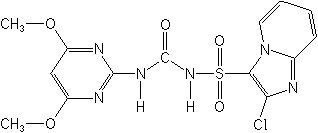-
Common NameImazosulfuron
-
中文通用名唑吡嘧磺隆
-
IUPAC1-(2-chloroimidazo[1,2-a]pyridin-3-ylsulfonyl)-3-(4,6-dimethoxypyrimidin-2-yl)urea
-
CAS2-chloro-N-[[(4,6-dimethoxy-2-pyrimidinyl)amino]carbonyl]imidazo[1,2-a]pyridine-3-sulfonamide
-
CAS No.122548-33-8
-
Molecular FormulaC14H13ClN6O5S
-
Molecular Structure
-
Category
-
ActivityHerbicide
Imazosulfuron is absorbed mainly through the root system. Weeds are killed gradually as the product is translocated through the plant. In rice, it is rapidly metabolised, resulting in good crop safety, under a range of climatic conditions. Slight growth retardation, but no significant damage, has been noted in the rice crop at levels almost twice those recommended. Imazosulfuron has residual activity lasting up to 50 days. Takeda recommends the use of imazosulfuron in sequence with pre-emergence products, 10 to 15 days after transplanting.
Takeda reports that Cyperus serotinus is particularly sensitive to the herbicide. At dose rates less than 3 g ai/ha the weed becomes stunted and shows chlorotic and necrotic symptoms. Death occurs at dose rates greater than 10 g ai/ha.
For the post-emergence winter wheat market in Germany, imazosulfuron will be applied in autumn for the control of Capsella bursa-pastoris, Chenopodium album, Lamium spp, Lepidium spp, Matricaria spp, Myosotis and Veronica spp. Winter treatments will control of Capsella bursa-pastoris and Matricaria spp. The product can be applied at weed growth stages BBCH10-12 in autumn and BBCH 21-29 in winter. For broad spectrum control, a graminicide partner will be required.
Imazosulfuron has been found to not be harmful to bees and aquatic organisms and presents low risk to beneficial arthropods. -
CropUseCropUses:
rice, wheat, barley
90 g ai/ha (paddy rice)
500-1000 g ai/ha (turf)
-
Premix
Granule (GR) ;Wettable powder (WP) ;suspension concentrate.
Premix Parters: carboxin metalaxyl; chloroneb;
-
Physical PropertiesMolecular weight:412.8; Physical form:Crystalline powder. Density:1.574 g/ml (25.5 °C); Melting point:183-184 °C ( decomp.); Vapour pressure:4.5 ×10-5 mPa (25 °C); Partition coefficient(n-octanol and water):logP = 0.049 ( pH 7, 25 °C); pKa:4.0; Solubility:In water 6.75 ( pH 5.1), 67 ( pH 6.1), 308 ( pH 7.0) (all in mg/l, 25 °C). In acetonitrile 2500, ethyl acetate 2200, acetone 4800, dichloromethane 12 900, xylene 400
-
ToxicologyOral:Acute oral LD50 for rats and mice >5000 mg/ kg. Percutaneous:Acute percutaneous LD50 for male and female rats >2000 mg/kg. Not irritant to eyes and skin (rabbits); not a skin sensitiser (guinea pigs). Inhalation: LC50 (4 h) for rats >2.4 mg/l air.
-
Environmental Profile
Ecotoxicology:
Bees: LD50 (48 h) (oral) 48.2 μg/bee; (contact) 66.5 μg/bee.Birds:Acute oral LD50 for bobwhite quail and mallard ducks >2250 mg/kg. Dietary LC50 (5 d) for bobwhite quail and mallard ducks >5620 ppm.Daphnia: LC50 (3 h) >40 mgl.Fish: LC50 (48 h) for carp >10 mg/l.
Fate in soil:
Imazosulfuron is degraded by chemical hydrolysis in aerobic conditions with a half-life of around 60 days. In anaerobic conditions, imazosulfuron undergoes microbial degradation resulting in a half-life of three days. No accumulation in soils has been noted. -
Transport InformationSignal Word:CAUTION; Hazard Class:III(Slightly hazardous)
Porduct NewsMore
Sumitomo Chemical launched new rice herbicide Maslao in Japan
Imazosulfuron Pyriminobac-methyl fenquinotrione

 0
0 Subscribe
Subscribe
